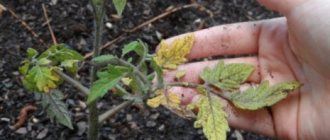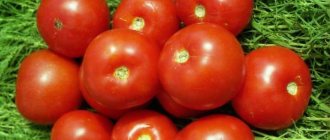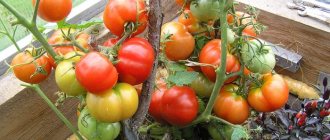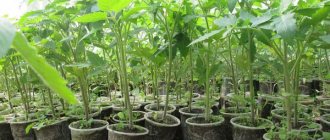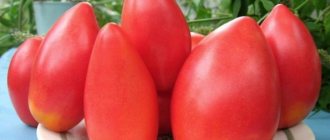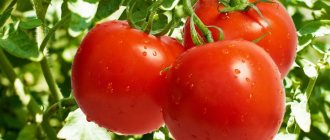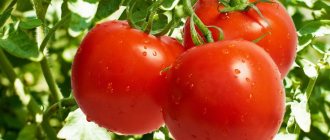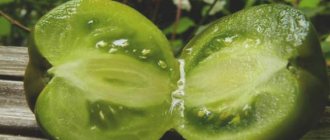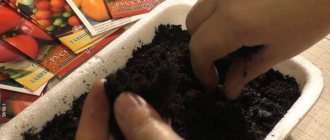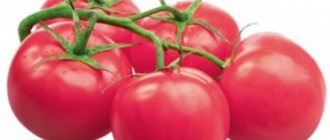Tomato VIP F1 is a worthy guest in the garden. It is impossible not to pay attention to him. High-yielding bunches with 6-7 tomatoes look appetizing and have a delicious taste.
| Height | Landing location | Ripening time | Fruit color | Fruit size | Origin | Fruit shape |
| Medium height | Greenhouse, Open ground | Early ripening | Reds | Average | Hybrid | Flat-round |
Description
An important person is an early ripening, determinate, low-growing hybrid f1. Designed for cultivation in open ground, home and industrial greenhouses.
Appearance of the hybrid
The bush is compact, does not require pinching, reaches a height of 35-110 cm in open soil and 1.5 m in a greenhouse. The leaf blade is green, medium in size. The inflorescence is simple. The tomato forms 3-4 simple leaves while growing in open ground.
One cluster produces from 5 to 8 fruits.
Distinctive features
An important person has the following features:
- resistance to drought, high humidity;
- suitable for long-term transportation without loss of presentation;
- the growing season is 95-100 days;
- resistant to late blight, alternaria, tobacco mosaic, root and crown rot, fusarium, bacterial spot;
- universal - tomatoes are added to salads, pickles, marinades.
Important! An important person is valued not only for its ease of care, but also for its excellent taste. Even a damp and cool summer cannot harm the fruits and deprive them of their juiciness and fleshiness.
Fruit characteristics, yield
The hybrid boasts:
- fruits are flat-round in shape, slightly ribbed at the base;
- rich red color;
- resistance to cracking - the peel is dense, matte, pleasant to the touch;
- sweet and moderately dense pulp;
- good yield.
One ripe fruit can weigh 130-160 g. From 1 sq. m of plot, 26 kg of ripe fruits are collected, and from 1 bush - 3-3.5 kg. But there have been cases when some specimens in greenhouses reached a weight of 200-250 g.
Characteristics of a hybrid frost-resistant tomato An important person and growing by seedlings
Created by domestic geneticists, the VIP F1 tomato is designed for growing in conditions of high humidity and unstable weather. Tomatoes of this variety are most in demand in the Far Eastern regions, where they are officially included in the register.
Consumer reviews and descriptions from gardeners clearly indicate the high commercial qualities of tomatoes, good yield, endurance and survival of the bushes. Plants bear fruit equally well in greenhouses and in open ground. They tolerate cold cyclones and periods of multi-day heat without much damage.
Main characteristics of the variety
The growth of the bush is limited to a height of 100-110 cm, in greenhouses it can reach 150 cm. On the one hand, this is convenient for picking tomatoes, since you do not need to constantly bend over. On the other hand, growing tomatoes will require spending effort, time and material resources. Installation of supports or tying is required.
The stem is strong and flexible; it bends under load and wind, but does not break. The foliage is dense and dark green. The leaves are large and dense, well protect the fruits from bright sunlight, hail and debris falling from above.
Tomatoes ripen in clusters containing at least 4 fruits. On average, 5 clusters of 5 tomatoes each ripen on 1 bush. Tomatoes have a round, slightly flattened shape. The base is slightly ribbed, with no greenery at the base. The peel is dense, matte, red. The average fruit weight is 150 g; when grown in a greenhouse, individual fruits reach 200 g.
Thanks to the large amount of dry substances, the pulp breaks down well, without being crushed too much and without a lot of splashing. Gourmets highly characterize the taste of VIP tomatoes. They are noted for their spicy aroma and pronounced sweet tomato taste.
The high yield of the variety is noteworthy. Under cover and with proper care, it can be 28 kg per 1 m². Ripening occurs smoothly, which greatly simplifies the gardener’s work.
The biggie is the all-purpose tomato. The small size of the fruit makes it convenient to prepare slices and salads. Tomatoes are rolled into jars and preserved in barrels. Green and red fruits are used equally successfully. Tomatoes are used to make delicious juice, ketchup and a variety of seasonings. Ripe fruits tolerate long-term transportation and long-term storage.
Pros and cons of the variety
Farmers and gardeners note the high resistance of the Important Person tomato to almost all infectious and fungal diseases.
If the plant is grown correctly, regularly watered and fed, then it successfully resists viruses:
- root and top rot;
- bacterial spotting;
- tobacco mosaic;
- Alternaria;
- fusarium;
- late blight.
The advantages of the variety do not end there. Gardeners have noted its excellent resistance to weather changes, sudden changes in temperature and air humidity. Everyone is especially pleased with the abundant harvest that can be harvested in the summer, and capturing part of the autumn. The ability of green and ripe tomatoes to retain their commercial qualities for up to six months is also valued. To do this, they should be placed in dark and cool rooms with good ventilation.
Seedling preparation and care
Tomatoes of the Important Person F1 variety belong to the category of crops resistant to low temperatures. You can sow seeds in containers as early as the third decade of March. You need to focus on the long-term weather forecast. The soil in containers should be made as fertile as possible by adding organic matter. Before laying, the seeds should be treated with an antiseptic.
They are placed in small depressions and sprinkled with a layer of earth up to 1 cm thick. Watering is carried out with a spray bottle so that the moisture is distributed evenly. Hardening of seedlings should be carried out as soon as the first shoots appear. The duration of each session should not exceed 2 hours. Before this, the plants should not be watered.
The seedlings are ready for planting 2 months after sowing the seeds. It is planted in the ground according to a 40x50 cm pattern at a distance of 100 cm between the beds.
The first fruits appear after a month. Caring for plants is quite simple. They need to be watered regularly, increasing the volume of water in hot weather. To reduce water consumption and reduce maintenance time, it is advisable to install a drip irrigation system. When watering by hand, water is applied with a watering can to the root.
Throughout the entire fruiting season, tomatoes need to be fed periodically, alternating organic matter, chemicals and combined mixtures. According to the rules of agricultural technology, the soil should be loosened and mulched, and treated against insects.
How to grow seedlings
According to the producers of Big Person, tomatoes have a strong immunity to the main nightshade diseases. In addition, hybrid seeds are treated at the production stage. But some gardeners advise playing it safe and disinfecting the seed.
Seed preparation
There are 4 ways to disinfect and stimulate growth - choose any:
- Dilute 1 g of potassium permanganate in 100 ml of water. Soak gauze in the solution and place the seeds in it. Keep it like this for 20 minutes. Then rinse and dry slightly.
- Dissolve 0.5 g of soda in 100 ml of water. Soak the seed in the solution for 1 day.
- Mix 1 tbsp. l. aloe juice and 1 tbsp. l. water. Soak the seeds for 15 hours. The solution will increase immunity, productivity and quality of plants.
- Dilute 1 drop of “Fitosporin” in 100 ml of water . Keep the seeds in the mixture for about 2 hours.
Attention! Whether or not to soak seeds is a personal decision for the gardener. Professionals recommend not paying attention to the ideal characteristics of varieties and hybrids, but following a clear plan.
Additionally, it is worth checking the planting material for defects. Dissolve 1 tbsp. l. salt in a glass of water. Dip the seeds into the solution. “Empty” ones will float to the surface - such material is removed.
Container and soil
You can choose any container as a “temporary house” for future seedlings. The soil is bought in a special store: universal soil contains all the minerals and vitamins necessary for tomatoes. However, before sowing seeds, it is better to disinfect the soil: infectious agents and pest larvae may persist in it.
Several methods of soil treatment:
- bake in the oven at a temperature of 180-240 °C for 20 minutes;
- heat in the microwave for 1-2 minutes;
- pour boiling water over the soil;
- soak in 1% solution of potassium permanganate.
Reference. The soil is prepared 20-25 days before sowing the seeds. During this time, the pathogens will die and the soil will become safe for further use.
Sowing
The seeds are immersed in a container with soil at the end of March. First, the soil is moistened, then planting material is placed on its surface. Sprinkle 1 cm of soil layer on top and spray with water from a spray bottle.
Growing and care
The containers can be placed on the windowsill so that the seeds receive enough light. The soil is moistened as it dries, preventing the formation of a dry crust. After the first shoots appear, the seedlings are hardened off. Do not water the plants before the procedure.
Hardening modes: during the day - 16-20 °C, at night - 8-10 °C. It is better to harden it this way: open a window or window every day for 1-2 hours, and in calm weather take the containers out onto the balcony.
After the formation of the first 2-4 true leaves, the plants are planted in separate containers.
How to grow tomatoes
The important person is an easy-to-care hybrid. However, experienced farmers recommend timely care for plants.
Landing
The seedlings are ready for planting 2 months after sowing the seeds. The following instructions will help you plant plants correctly:
- Prepare the area. Dig a shallow trench along the bed - about 30 cm. Form 5-6 holes in the trench, at a distance of 40 cm from each other. The passage between the “ribbons” is 80 cm.
- Fertilize the holes. 24 hours before planting the tomatoes, add 1 glass of a weak solution of manganese and the same amount of yeast mixture to each hole (dilute 10 g of yeast in 10 liters of water and let it brew for 24 hours). Then pour in 100 g of eggshells and wood ash.
- Plant plants. Place each bush in its own hole so that the stem goes 2 cm deep into the ground. Sprinkle soil on top, mulch and water well.
Important! If the seedlings have grown too early, you can slightly delay the fruiting period. It is enough to remove the first flowering branch, but with extreme caution. The second such branch will appear in 7 days, and the tomato can already be planted in open ground.
Care
Procedure for caring for tomatoes:
- Watering. Drip irrigation is optimal for tomatoes. Such systems are sold in specialized stores. The equipment is worth using if you grow tomatoes for industrial purposes. For an ordinary gardener, it is enough to pour one bucket of water under each bush, being careful not to wet the leaves and skin of the fruit. It is recommended to water the plants as the soil dries out.
- Weeding . Weeds are removed as they appear. This will prevent the appearance of pests on the site.
- Loosening . The soil is loosened in the daytime to a depth of 5-7 cm to improve root aeration.
- Bush shaping . Remove dry, yellow leaves from the bush. If the plant has become too wide, carefully remove the branches (but not the inflorescences).
- Garter. Place supports near the tomatoes to prevent the plants from breaking (especially when the fruits are ripening).
- Mulching. Cover the soil with dark material to prevent infectious diseases from affecting the tomatoes.
Without fertilizing it is impossible to get a rich and tasty harvest. Here are some recommendations:
- The first fertilizing is applied 2-3 weeks after planting. Manure is diluted with water in a bucket in a ratio of 1:5. Then the mixture is infused for a couple of weeks, again diluted with water 1:2. Apply 1-2 liters of liquid under each bush.
- The second feeding is applied during the flowering period. Manure is prepared according to the previous principle. Additionally, dilute 1 drop of iodine and 2 tbsp in 1 liter of warm water. l. whey. The leaves are sprayed with this mixture.
- The third feeding is necessary during fruit formation . Manure can be replaced with chicken droppings, but this solution must be infused for 10 days.
Important ! You can feed tomatoes with complex fertilizers. They are sold in special stores. Follow the manufacturer's recommendations.
SUPER FEEDING TOMATO!!!!! Be sure to try it!!!
Features of cultivation and possible difficulties
Growing tall Bigwig is no different from growing other varieties. But the hybrid requires a lot of space for normal development: approximately 1 sq. m for 3 plants. After the stems get stronger and stretch out, they need to be tied to a trellis.
Difficulties may arise when watering. Excess moisture can cause excessive leaf growth (this inhibits fruit development). Insufficient watering leads to loss of ovaries (they crumble). A beginner should carefully monitor soil moisture.
Reference. Difficulties with watering can be solved with mulch. It will retain moisture and prevent an increase in air humidity. Mulch can be in the form of grass clippings or straw. Additionally, it will protect plants from late blight.
Diseases and pests
The most dangerous diseases: late blight, brown spot, mosaic, gray and brown rot, blackleg. To prevent the occurrence of diseases, it is enough to disinfect planting material, water moderately, and observe crop rotation.
Pests: mole crickets, click beetle larvae, aphids, cutworms, whiteflies. The drug "Phosbecid" will help control insects. Dilute 10 ml of the product in 10 liters of water and spray the plants with the solution. Two treatments will be required with an interval of 15-20 days.
Features of the variety
The important person is the determinant. The height of the bush reaches 110 cm in open ground and 1.5 m in a greenhouse. The plant has a few dark green, medium-dissected leaves that can protect it from scorching sun rays and rain. Tomato inflorescences are simple, they are combined into 5 or 7 clusters on each bush. The tomatoes inside them are the same size.
Let's consider the main distinctive features of the fruits of the variety:
- Flat-round shape, slightly ribbed near the base.
- The red color of ripe tomatoes that do not show cracks. They contain 6.5% dry matter.
- Sweet and not very dense pulp inside.
- Good yield: 26 kg. per 1 sq. m., if there is film.
We must not forget about resistance to common plant diseases, including:
- late blight, alternaria;
- tobacco mosaic, root and crown rot;
- fusarium, bacterial spot
The growing season of the variety is 95-100 days.
Big Person is a universally applicable variety. It is added to salads, pickles, marinades.
One of the important advantages of tomatoes is their resistance to transportation over long distances without losing their presentation.
Farmer reviews
Reviews from gardeners about the results of growing VIP are mostly positive.
Lyudmila, 40 years old, Omsk: “An important person deserves a solid A.” The description on the package with seeds and the photo corresponds to the result obtained.”
Elizaveta, 38 years old, Krasnodar: “The tomatoes didn’t get sick during the season, although I still treated the seeds just in case. It’s convenient that you don’t have to stepchild.”
Anna, 53 years old, Ufa: “I had to give up the entire greenhouse for tomatoes. The harvest is not bad, but next year I’d rather plant several different varieties in the same area.”
